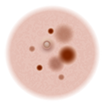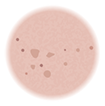Condition
Pigmentation
Skin pigmentation disorders affect the color of the skin and are caused by an excess of melanin production. They can occur in small patches, cover large areas, or affect the entire body.
Types of Pigmentation

PIH

Melasma

Age Spots

Freckles
What causes it
What causes Pigmentation?
Pigmentation is caused by an excess production of melanin, a pigment that gives skin its color. It is produced by skin cells called melanocytes. Several factors can trigger melanin production, including:
Sun exposure
Sunlight triggers the production of melanin, which acts as the skin’s natural defense by protecting it from harmful UV rays. However, excessive sun exposure can disrupt this process, leading to hyperpigmentation.
Once pigmentation has developed, sun exposure can worsen the issue, making age spots, melasma, and post-inflammatory hyperpigmentation (PIH) appear darker.
Aging
As skin ages, the number of melanocytes decreases, but the remaining ones increase in size. Additionally, our skin becomes thinner and more prone to dehydration as we get older. As a result, melanin becomes more superficial, leading to pigmentation.
Hormones
Hormonal influences are a primary cause of a type of hyperpigmentation known as melasma. It is common in women and occurs when estrogen and progesterone stimulate the overproduction of melanin.
Inflammation/Skin injury
Post-inflammatory hyperpigmentation (PIH) occurs following skin injury or inflammation, such as acne, cuts, burns, or allergic reactions. The skin cells respond to damage or irritation by producing extra melanin, which results in darkened or discolored patches or spots after the wound has healed.
Skin hydration is essential in the treatment of pigmentation disorders. Additionally, a combination of oral, topical, and laser treatments can be effective for managing pigmentation. .

Treatment Options
GEM Clinic offers oral depigmenting therapy, which can be used alone or in combination with other treatment modalities (laser and topical) depending on the type of pigmentation.
Similar Conditions
Acne scars are the result of inflammatory acne. When acne swells and breaks the follicle wall, the skin attempts to repair the damage by forming new collagen fibers. However, the repair may not be as smooth, which can lead to the formation of acne scars.
Schedule A Consultation
Being results driven, GEM Clinic provides consultations personally by our doctors to assess client's concerns. Our doctors will determine the best suited treatment to deliver the most optimal results for you!